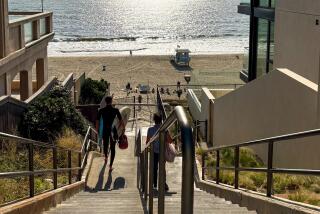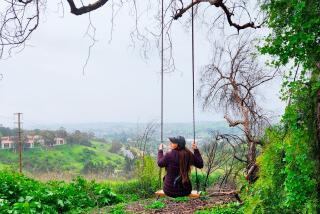Trekking Along Britain’s South Coast
- Share via
CHICHESTER, England — Along the ridge of chalk hills backing England’s southeast coast runs a grassy track that has served as a footpath from time beyond memory.
For 80 miles the South Downs Way clings like a faded green ribbon to moors and meadows dotted with ancient burial mounds. It winds through a rolling upland cropped close by sheep and furrowed by the plow.
At Rodmell the path drops to the Valley of the Ouse and Virginia Woolf’s erstwhile haunts. Near South Harting in the west it skirts that handsome old manor house, Uppark, where H. G. Wells, the son of a servant, wrote his first stories.
The ridge track ranges deep into Sussex from the Hampshire border to Eastbourne on the English Channel. To hike its length takes the better part of a week.
Sussex Villages
Far less arduous, yet equally rewarding, is a long afternoon’s outing that covers an 11-mile stretch between a pair of mossy Sussex villages--Cocking, with its 14th-Century church, and Houghton, washed by the languid River Arun.
There are easy bus and rail connections from and to the region’s chief town, Chichester.
Just 50 miles from London, the trek surveys some of the most glorious countryside in Britain, and except at scattered road crossings its prime attraction is rural tranquillity undisturbed by motor traffic.
All a visitor really needs is a decent pair of walking shoes and a healthy amount of stamina.
The Cocking section of the walk begins half a mile from the village, where the South Downs Way intersects the Chichester-Midhurst road (A-286) 8 1/2 miles north of Chichester. A wooden signpost points to the path, straggling up the steep flank of Manofarm Down.
Through the Woods
Hikers have a hard slog to the 600-foot summit. There the track levels off. It tunnels through a three-mile wood of fir and beech before emerging in the clear atop Litleton Down.
Ahead, the path seems to fade in a cow pasture but is quickly picked up again as a faint thread falling diagonally to the busy Chichester-Petworth road (A-285). Once on the other side, the path cuts a broad gap between earthen banks, and wayfarers soon put the din of cars behind them.
The signposted track climbs steadily to the crest of Sutton Down through wheat fields edged with purple thistle and cottony tufts like an old man’s beard. Here, too, the loveliest of all chalkland flowers, the scabious, raises its delicately rounded lavender head.
Now follows a magnificent stretch of country. A little more than a mile of exhilarating walking leads to the western spur of Bignor Hill.
In the south the downs (the word derives from the Old English dun , meaning hill) shelve to a patchwork tapestry of lowland farms pierced by the far-off spire of Chichester Cathedral.
Beyond, visible for the first time on the route, is the metallic glint of the sea.
Old Roman Road
The path dips gently eastward. Studded with flints, it bears left along a raised remnant of the original Stane Street. This was the laser-straight, stone-paved road that Roman conquerors built to link 1st-Century Chichester, then called Noviomagus, with London, or Londinium.
After a few hundred yards, walkers turn right across a cattle grid where the path, still clearly signposted, eases up a chalk-stippled field to Bignor Hill’s 727-foot crown.
The downs land spreads out in the east. As far as the eye can see, the surging rampart of turf-mantled chalk curls to the wide horizon like a long, low wave about to break.
It dominates the landscape, mysterious and aloof, yet with a quiet nobility that soothes the spirit and enchants the eye.
Northward the downs forms an escarpment that drops abruptly to a sweeping plain speckled with storybook villages of thatch and flint: Sutton and Barlavington close by; the red roofs of distant Petworth huddled round a stately mansion of honey-colored stone.
Undisturbed Hike
On these heights grazing sheep, pecking pheasants and an occasional fellow hiker or horseback rider are the walker’s only companions. The sky invariably is filled with clouds. Sunlight and shadow chase each other across the folding hills.
From Bignor Hill walkers trot down a steep incline to the base of Westburton Hill. There, at three corrugated metal barns, the path splits.
The left branch detours west a mile to the remains of a Roman farm villa unearthed at Bignor (the mosaics alone are worth a visit). The right continues east along South Downs Way.
The chalky track wanders high across open fields. Beyond the A-29 road the path drifts down to a vivid green flood plain creased by the waters of the Arun.
An Old Pub
For day-trekkers the end comes at nearby Houghton, a comely hamlet graced by an agreeably antiquated pub, the George & Dragon.
This is where King Charles II is reputed to have stopped in 1651, so a plaque says, “to take ale.”
As in Charles’ time the George is just the place to savor a malty pint against the splendid backdrop of Sussex Downs. It provides a welcome respite from the dust of the trail and a satisfying cap to a memorable day.
-- -- --
With its wealth of hotels and fine dining, Chichester makes a good base for exploring the nearby downs. The old south coast cathedral town is a 1 3/4-hour train ride from London.
Drivers should follow the M-4 and M-25 Motorways to routes A-3 and A-286. For extended touring, a car is essential.
The “Car Rental in Britain” package that British Airways offers passengers is a good value: $17 a day for a subcompact with unlimited mileage (tax and insurance extra). Bookings must be made before departure from the United States.
The South Downs Way is one of 14 government-maintained, long-distance footpaths in Britain. To get to the Cocking-Houghton leg of the trail, take a No. 260 bus from Chichester Bus Terminal Southgate to the footpath’s crossing of Route A-286 at Hillbarn Lane.
Service is hourly, the fare $2. The return is by train from Amberley Station, half a mile down the Storrington road from the George & Dragon in Houghton.
Good Bus Service
There is hourly service, with a change at Barnham. The fare is $3. For taxis, contact Dunnaway’s of Chichester (782-402).
The weather is changeable on the downs; a sweater and raincoat are musts. Ordnance Survey map 197 and the larger-scale SU81/91, both covering the Cocking-Houghton section of the way, can be obtained in Chichester at any bookstore or in London at Stanfords International Map Centre, 12-14 Long Acre.
An excellent 76-page guide, “Along the South Downs Way,” also is available in Chichester bookstores.
For more information, contact the British Tourist Authority, 350 S. Figueroa St., Los Angeles 90071, phone (213) 628-3525. It has specifics about hotels, restaurants and walking and touring in and around Chichester. For trekking elsewhere in England, Scotland and Wales, ask for a free copy of the “Walking in Britain” brochure.
Standout hotels in Chichester include the Dolphin & Anchor (West Street, about $75 double) and the Ship (North Street, $65).
More to Read
Sign up for The Wild
We’ll help you find the best places to hike, bike and run, as well as the perfect silent spots for meditation and yoga.
You may occasionally receive promotional content from the Los Angeles Times.






